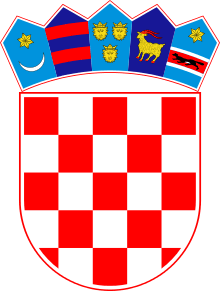Kaštela
Kaštela (Croatian pronunciation: [kǎʃtɛla]; Italian: Castelli) is an agglomeration of seven small towns in Croatia which are administered as a single municipality. Located northwest of the city of Split, west of Solin and east of Trogir, on the central Dalmatian coast, Kaštela are part of the Split-Dalmatia County. With a total population of 38,667 as of 2011 census within its limits, individually ranging from 3,000 to 7,000 residents, they are the 15th largest municipality in the country.
Kaštela | |
|---|---|
| Grad Kaštela Town of Kaštela | |
%2C_2011-09-11.jpg)     Top: Kaštel Sućurac; Kaštel Gomilica; Center: Kaštel Kambelovac; Kaštel Lukšić; Kaštel Novi; Bottom: Kaštel Štafilić; Kaštel Stari | |
 Kaštela Location of Kaštela in Croatia  Kaštela Kaštela (Croatia) | |
| Coordinates: 43°33′N 16°23′E | |
| Country | |
| County | |
| Government | |
| • Mayor | Denis Ivanović (HDZ) |
| Area | |
| • Total | 57.67 km2 (22.27 sq mi) |
| Elevation | 3 m (10 ft) |
| Population (2011) | |
| • Total | 38,667 |
| • Density | 670/km2 (1,700/sq mi) |
| Time zone | UTC+1 (CET) |
| • Summer (DST) | UTC+2 (CEST) |
| Postal code | 21212 |
| Area code(s) | 021 |
| Vehicle registration | ST |
| Website | www |
Geography
- Subdivision
The Kaštela (which is plural of Kaštel) include (populations parenthesised):
- Kaštel Gomilica (4,881)
- Kaštel Kambelovac (5,027)
- Kaštel Lukšić (5,425)
- Kaštel Novi (6,411)
- Kaštel Stari (7,052)
- Kaštel Sućurac (6,829)
- Kaštel Štafilić (3,042)
Overview
The Kastela Riviera is a fertile area, about 20 kilometres (12 miles) in length, featuring the first Roman floating docks and 50 places on the long, verdant area, northwest of Split. It is divided into Gornja (upper) and Donja Kastela (lower), and it consists of seven old and two relatively new settlements. The Kastela region with its Mediterranean tone, picturesque landscape and unique composition of natural environment attracted people since prehistoric times. From ancient Greek sailors, Roman patricians, Croatian kings, rulers, Venetian royals to the present sun and sea lovers, as well as mysterious legacies from the past.
Once an ancient Greek port, a stopover point for Roman veterans and a summer place for Croatian kings is today a tourist resort, carrying the same name. Along its long sandy beach there are terraces and viewpoints, tennis and other sports grounds, surrounded by greenery of pine and tamaris trees.
The Jadro River (the original water supply for the ancient city of Diocletian's Palace)[1] flows through the town of Solin and provides water supply to both Split and Kaštela. Contemporary studies indicate favourable water quality levels of the river near the headwaters at Jadro Spring.[2] Certain other studies of hydrology and sedimentation have been conducted in this area.[3]
Economy
The industrial zone is developed, and there is an aluminium extraction facility in the vicinity of Kaštel Sućurac and Resnik, the airport of Split, is in Kaštel Štafilić. Present area of Kastela and its inland in the vicinity of ancient Salona were inhabited very early (the finds from the Roman and Old Croatian period).
Twin towns
Kaštela is twinned with:








See also
References
- C.Michael Hogan, "Diocletian's Palace", The Megalithic Portal, A. Burnham ed, Oct 6, 2007
- Nives Štambuk-Giljanović, The Pollution Load by Nitrogen and Phosphorus In the Jadro River, Springer Netherlands, ISSN 0167-6369 (Print) 1573-2959 (Online), Volume 123, Numbers 1-3 / December, 2006
- P. Zannetti, Environmental Modeling: Computer Methods and Software, 1996, Computational Mechanics Publications, 462 pages ISBN 1-85312-342-0
- "Gradovi prijatelji". kastela.hr (in Croatian). Retrieved 6 February 2020.

